Looking for the Best Way To Sell Pictures Online and monetize your photography skills? Whether you’re a seasoned professional or a hobbyist looking to generate passive income, the internet offers numerous platforms to connect you with buyers eager for high-quality stock images.
Stock photo websites act as intermediaries, licensing your photographs to businesses, agencies, and individuals who require visuals for commercial purposes. In return, you receive a portion of the revenue generated from these licenses.
This guide explores 15 of the top websites for selling your photos online and provides a step-by-step roadmap to transform your passion into a profitable venture.
Top Platforms for Selling Photos Online
1. Alamy
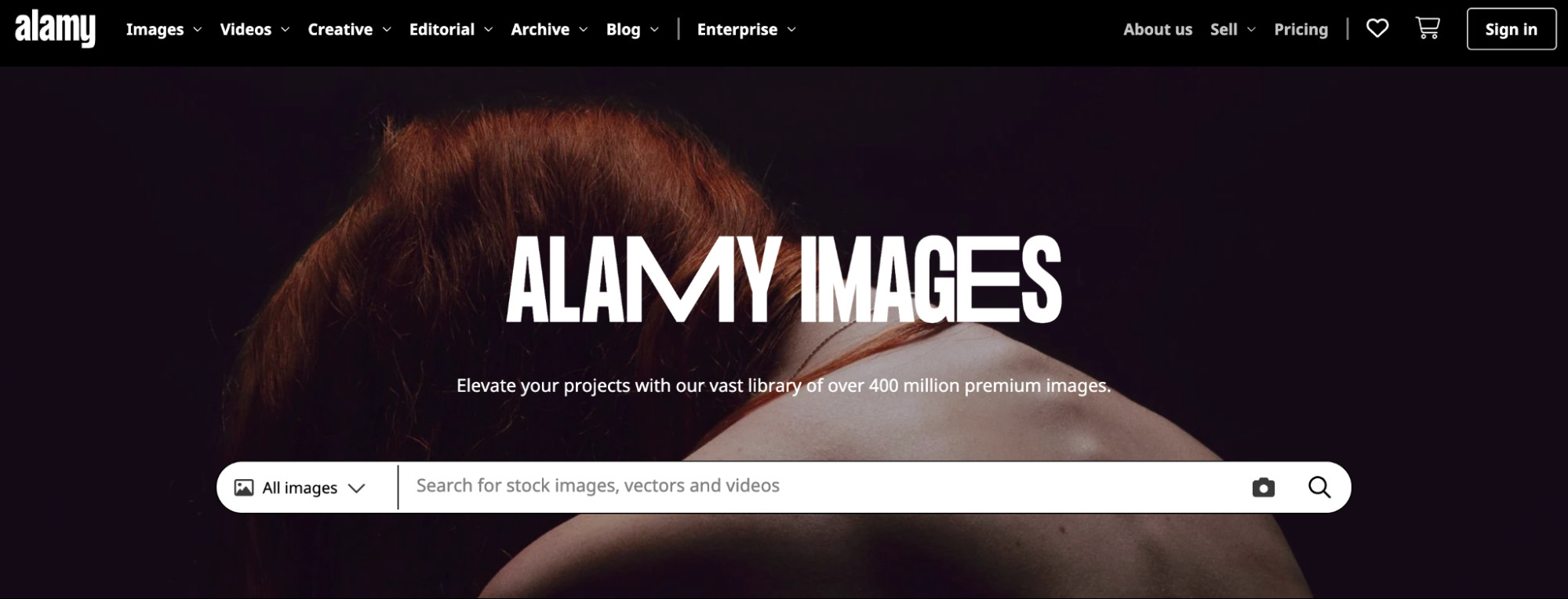 Alamy Images homepage showing a search bar for people to find royalty-free images.
Alamy Images homepage showing a search bar for people to find royalty-free images.
Alamy stands out with its vast and diverse collection of stock photos, making it a robust platform to sell your own photos online and earn commissions. Boasting millions of stock images, vector graphics, videos, and immersive 360-degree panoramic images, Alamy provides numerous avenues for photographers to contribute and tap into a wide market. For photographers on the go, Alamy also features Stockimo, an iOS app that enables you to sell photos directly from your smartphone, broadening accessibility and convenience.
Commission Structure
Alamy offers monthly payouts to its contributors with a tiered commission structure. Photographers can earn between 17% and 50% of each sale, with the commission rate fluctuating based on image popularity and the type of license purchased. Alamy prides itself on flexibility, offering no long-term contracts and facilitating payments in multiple currencies, accommodating a global contributor base.
2. 500px
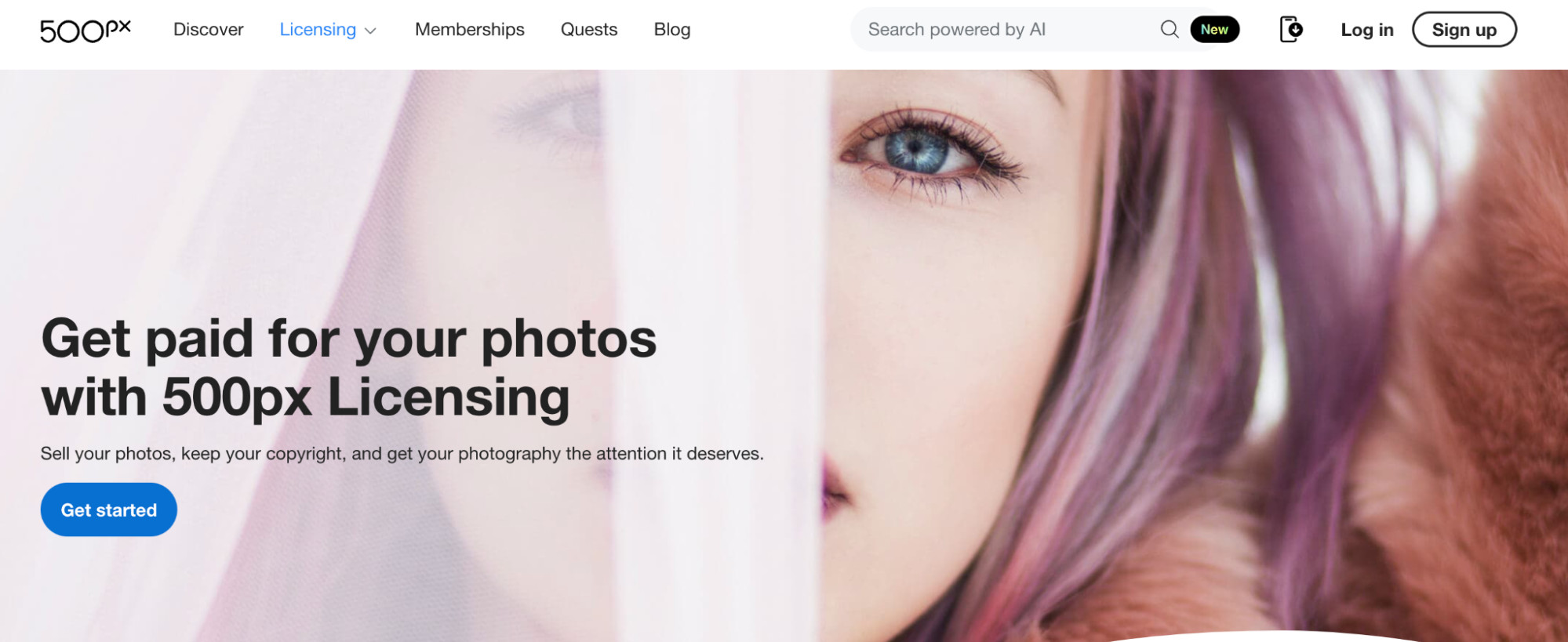 500px’s homepage that shows how contributors can get paid for their photos with licensing.
500px’s homepage that shows how contributors can get paid for their photos with licensing.
500px provides a unique blend of stock photo licensing with a vibrant community atmosphere. It serves as a platform for millions of photographers to sell and license their photos online, fostering a space for both commerce and connection. 500px employs a proprietary Pulse algorithm, designed to elevate the visibility of emerging photographs and photographers to potential clients. This algorithm offers a valuable opportunity for photographers who are newer to the scene to gain recognition, provided their submissions meet the platform’s quality standards.
Beyond being a marketplace, 500px cultivates an active online community for both amateur and professional photographers. Members can engage with fellow photographers, receive constructive criticism on their work, list photos for sale in the marketplace, and participate in photography competitions, offering opportunities for both exposure and prizes.
Royalty Benefits
For photographers who become paying members on 500px, the platform offers a significant incentive: the potential to earn up to 100% royalties on exclusive photos. This structure is particularly appealing for those looking to maximize their earnings from their unique and high-quality images.
3. Shutterstock
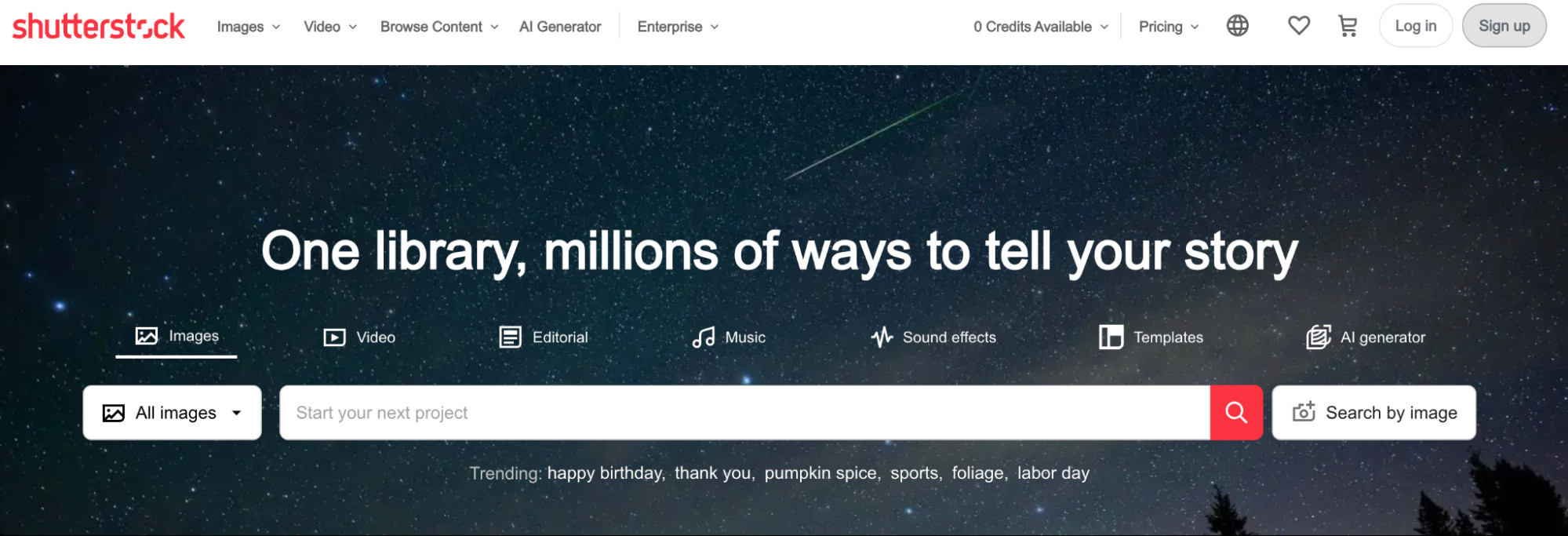 Shutterstock homepage that lets people find royalty-free images, video, and music.
Shutterstock homepage that lets people find royalty-free images, video, and music.
Shutterstock is recognized as a leading and highly popular stock photography website, making it a prime destination for those looking to sell photos online. As a well-established platform, Shutterstock boasts a strong reputation and has demonstrated financial success for its contributors, having paid out over $1 billion to its community in the past 15 years.
Shutterstock operates as a micro-stock site, characterized by offering photos at more affordable prices and under non-exclusive licenses. To achieve significant downloads and earnings on Shutterstock, the key strategy is to contribute a large volume of images. While the per-image earnings might be lower compared to some other platforms, Shutterstock provides a valuable entry point for photographers venturing into selling stock photos and learning the nuances of the market.
Earning Potential
The payout structure on Shutterstock is based on cumulative earnings over time, with royalty rates ranging from 15% to 40%. Additionally, Shutterstock offers an affiliate program, presenting an opportunity to earn supplementary income by referring new photographers or customers to the platform.
4. Getty Images
 Getty Images’ homepage with a search bar that helps people find photos and images.
Getty Images’ homepage with a search bar that helps people find photos and images.
Getty Images is known for its extensive library of premium stock photos, positioning itself as a go-to resource for brands and online publishers seeking high-caliber, exclusive, or niche images for licensing. Together with its microstock subsidiary, iStock (detailed below), Getty Images extends its reach to over 1.5 million customers worldwide, highlighting its significant presence in the global stock photo market.
To uphold its esteemed reputation among publishers and maintain the quality of its collection, Getty Images applies more stringent standards for photographers looking to contribute and sell their work on the platform compared to many other stock photo sites. This selectivity ensures that Getty Images remains synonymous with high-quality and exclusive imagery.
Application Process and Payouts
Prospective contributors need to apply to become a Getty Images photographer by submitting a portfolio of sample photos for review. Upon acceptance, contributors can expect to earn between 15% and 45% of an image’s license fee. The exact percentage can vary based on factors such as exclusivity and the type of license sold.
5. iStock
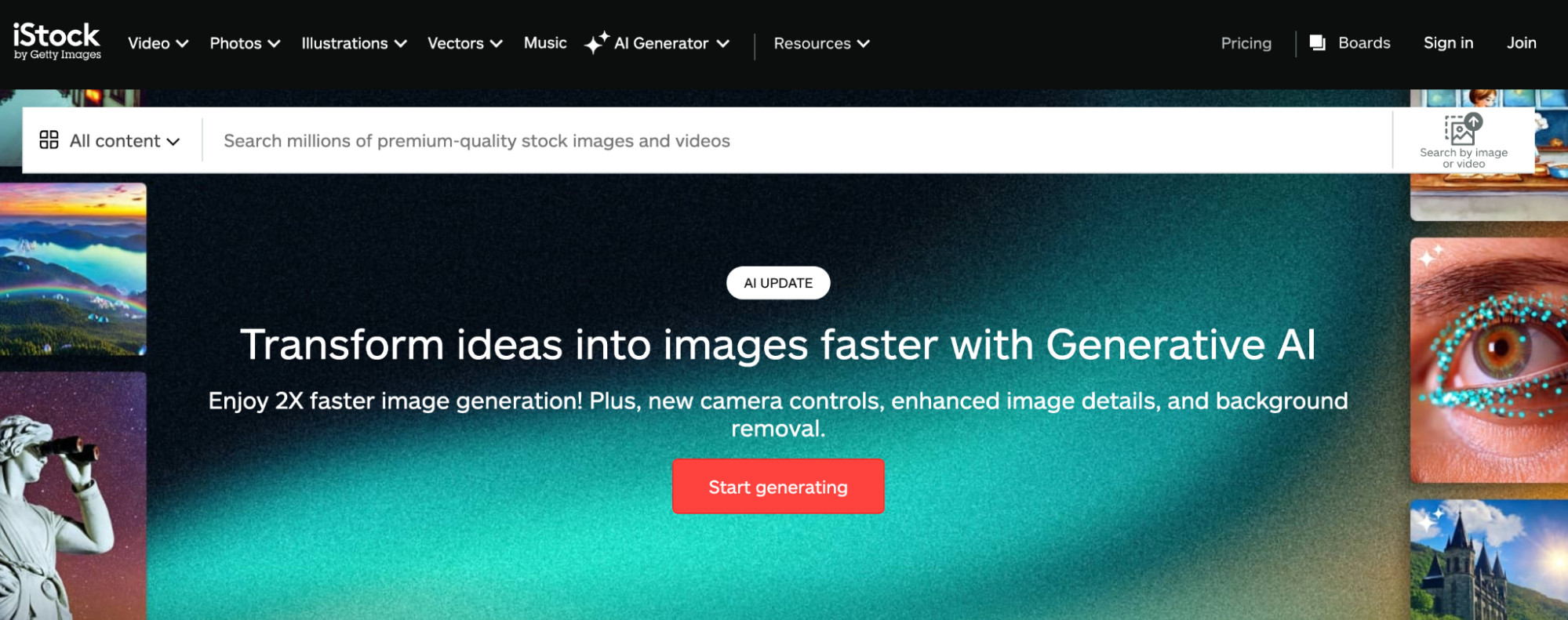 Landing page for iStock that shows its generative AI-powered image creator.
Landing page for iStock that shows its generative AI-powered image creator.
iStock operates as a non-exclusive contributor alternative within the Getty Images family, offering a different avenue for photographers to sell their work. As an offshoot of Getty Images, iStock’s primary distinction lies in its acceptance of non-exclusive photos. This means photographers have the flexibility to sell the same images through other stock photo agencies, increasing their potential for broader market reach and income generation.
Joining iStock as a Contributor
To start selling photos on iStock, photographers are required to apply by submitting a selection of sample images for evaluation. The commission structure at iStock mirrors that of Getty Images, ranging from 15% to 45%. The specific commission rate depends on the contributor agreement, which may take into account factors such as exclusivity and the volume of sales.
6. Stocksy
 Stocksy homepage with an art graphic of people in a library.
Stocksy homepage with an art graphic of people in a library.
Stocksy is designed as an accessible platform, particularly appealing to photographers who are newer to the stock photo market and looking to sell their work online. It has gained popularity as a stock photography site that offers notably high payouts to its contributors. Photographers on Stocksy can earn a 50% royalty on standard licenses and an even higher 75% royalty on extended licenses. However, Stocksy operates on an exclusivity model, requiring that all photos sold through the platform are exclusive to Stocksy.
Stocksy distinguishes itself as an artist-owned cooperative. This unique structure means that contributors are not just sellers but also part owners of the business. They have a voice in the co-op’s direction and can benefit from its financial success through profit-sharing, known as patronage returns, when the co-op achieves a surplus.
Payment and Application Details
Stocksy ensures timely payments to its contributors on a monthly basis, offering several convenient payment methods including PayPal, Payoneer, or check. The minimum payout threshold is set at $100. For photographers interested in joining Stocksy, it’s advisable to review their contributor application FAQ for detailed guidance on the application process and requirements.
7. Picfair
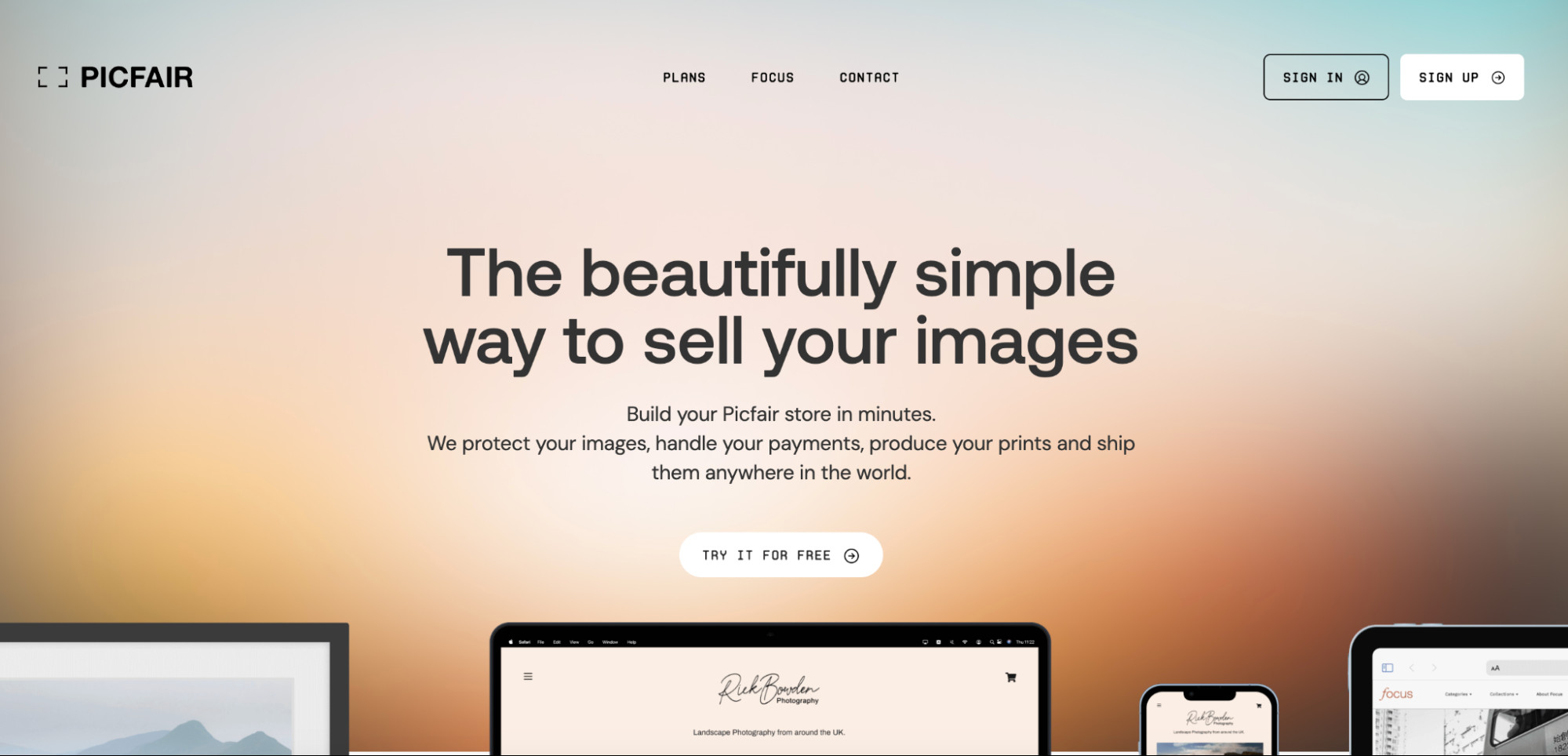 Picfair landing page for a website builder built for photographers.
Picfair landing page for a website builder built for photographers.
Picfair presents a compelling option for photographers who desire greater control over their online photo portfolio and sales process. It allows users to create their own photography ecommerce website, providing a platform to showcase and sell their work directly to customers. With Picfair, photographers have the autonomy to set their own prices for their photos, whether they are selling prints or digital downloads. The platform simplifies the sales process by handling payment processing, managing print production, shipping logistics, and licensing for digital images.
Picfair Plus Plan
To leverage the full suite of features Picfair offers, photographers can sign up for a Plus plan. This plan is priced at $5 per month when billed annually. The Plus plan enables users to establish a custom Picfair store capable of hosting up to 10,000 images. These images can be offered for sale as both physical prints and digital downloads, providing versatile sales options.
8. Adobe Stock
 Adobe Stock homepage showing a search bar against a photo of sting rays in the ocean.
Adobe Stock homepage showing a search bar against a photo of sting rays in the ocean.
Adobe Stock offers seamless integration with Adobe’s widely-used suite of photography software, making it a particularly convenient platform for photographers already working within the Adobe ecosystem. If you utilize Adobe Creative Cloud applications for your photography projects, Adobe Stock provides a direct pathway to add your images, videos, vectors, and illustrations to their online stock photo platform.
Integration and Royalties
A key advantage of Adobe Stock is the ability to upload assets directly from within Lightroom and Bridge once your editing process is complete. For contributors who link their Adobe ID to Adobe Stock, the platform offers a royalty rate of 33% on photos and a slightly higher 35% on videos. This integration streamlines the workflow for Adobe users and provides a straightforward route to monetize their creative assets.
9. Envato Elements
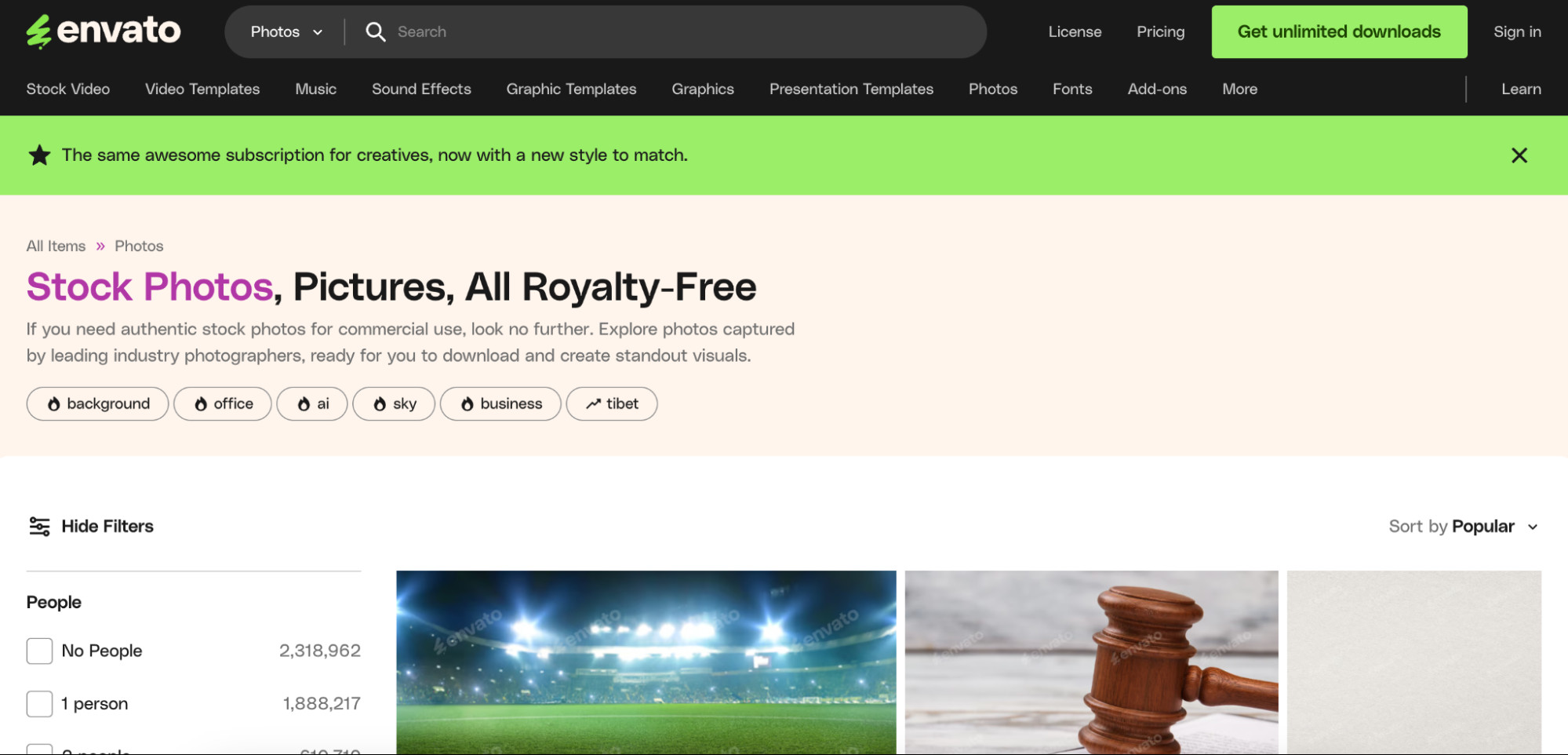 Landing page for stock photos on Envato Market.
Landing page for stock photos on Envato Market.
Envato Elements presents a unique revenue-sharing model within the stock photography market. By joining Envato Elements, photographers can tap into a platform where they can sell their photos online and connect with a broad audience of potential clients.
Envato Elements provides flexibility in how photographers can sell their work. You have the option to sell photos through the Envato Elements platform directly or to upload photos to your own website hosted on the Envato domain. Both avenues offer access to a popular marketplace for visual content and opportunities to generate income from your photography.
Revenue Sharing Model
Contributors to Envato Elements participate in a revenue-sharing system, earning between 25% and 50% of the net subscription revenue generated by the platform. This model aligns contributor earnings with the overall success of Envato Elements, offering a stake in the platform’s growth and subscriber base.
10. Unsplash+
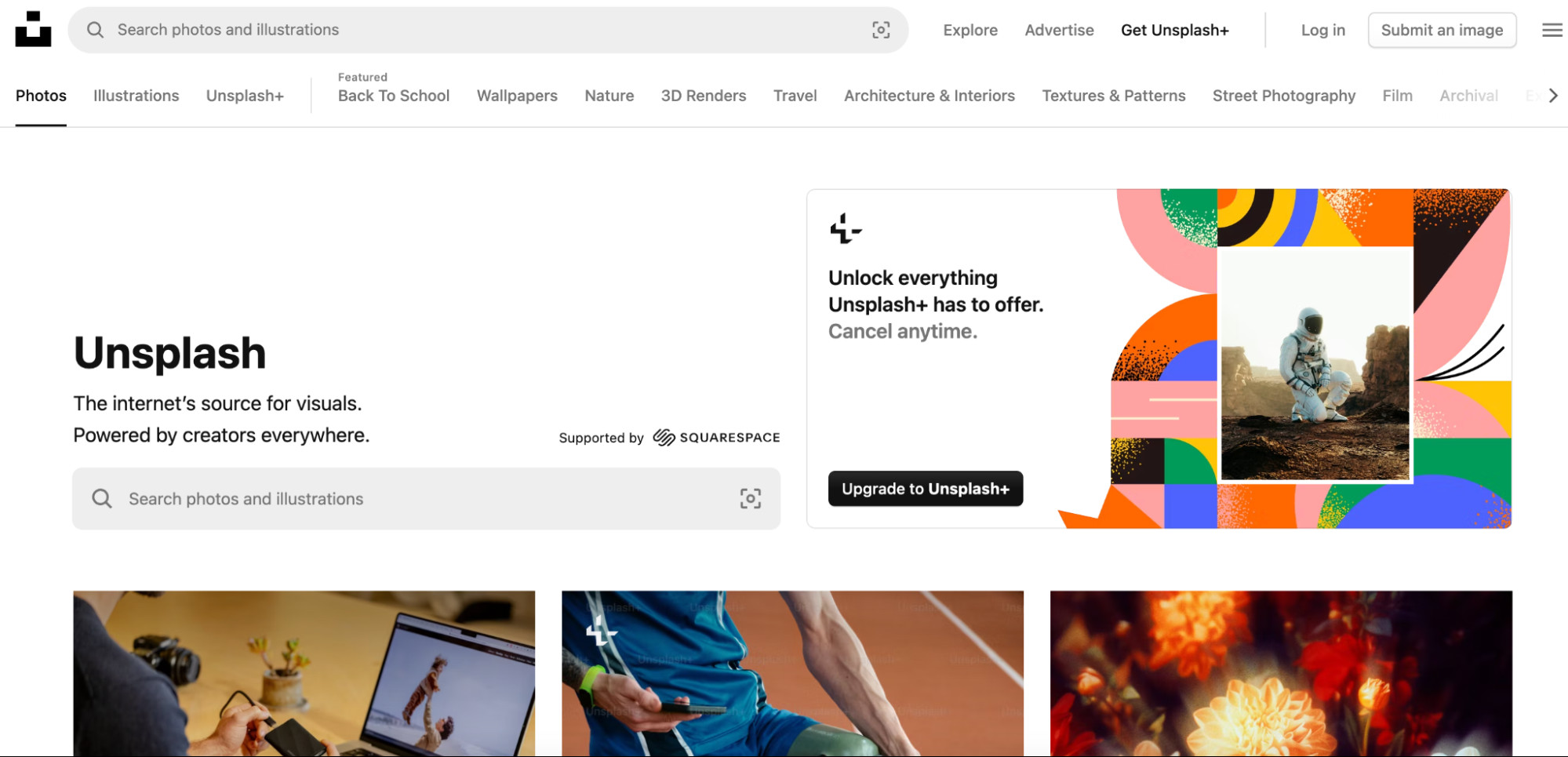 Unsplash homepage showing stock photos and a call-to-action for Unsplash
Unsplash homepage showing stock photos and a call-to-action for Unsplash
Unsplash, while widely known as a free stock photo site, also offers a program called Unsplash+ that provides photographers with paid opportunities. Owned by Getty Images, Unsplash+ operates on a different model compared to traditional stock photo sales. Instead of photographers earning based on individual photo sales, Unsplash+ partners with contributors through assignments and briefs.
Contribution and Payment Structure
To participate in Unsplash+, photographers need to complete a contribution application and be accepted into the program. Once approved, contributors gain access to a list of briefs and requests created by Unsplash customers. Photographers can then select briefs that align with their skills and interests, submit relevant photos, and get paid for each image that is accepted. The payment rates for photos on Unsplash+ vary, averaging between $5 and $30 per image.
11. Dreamstime
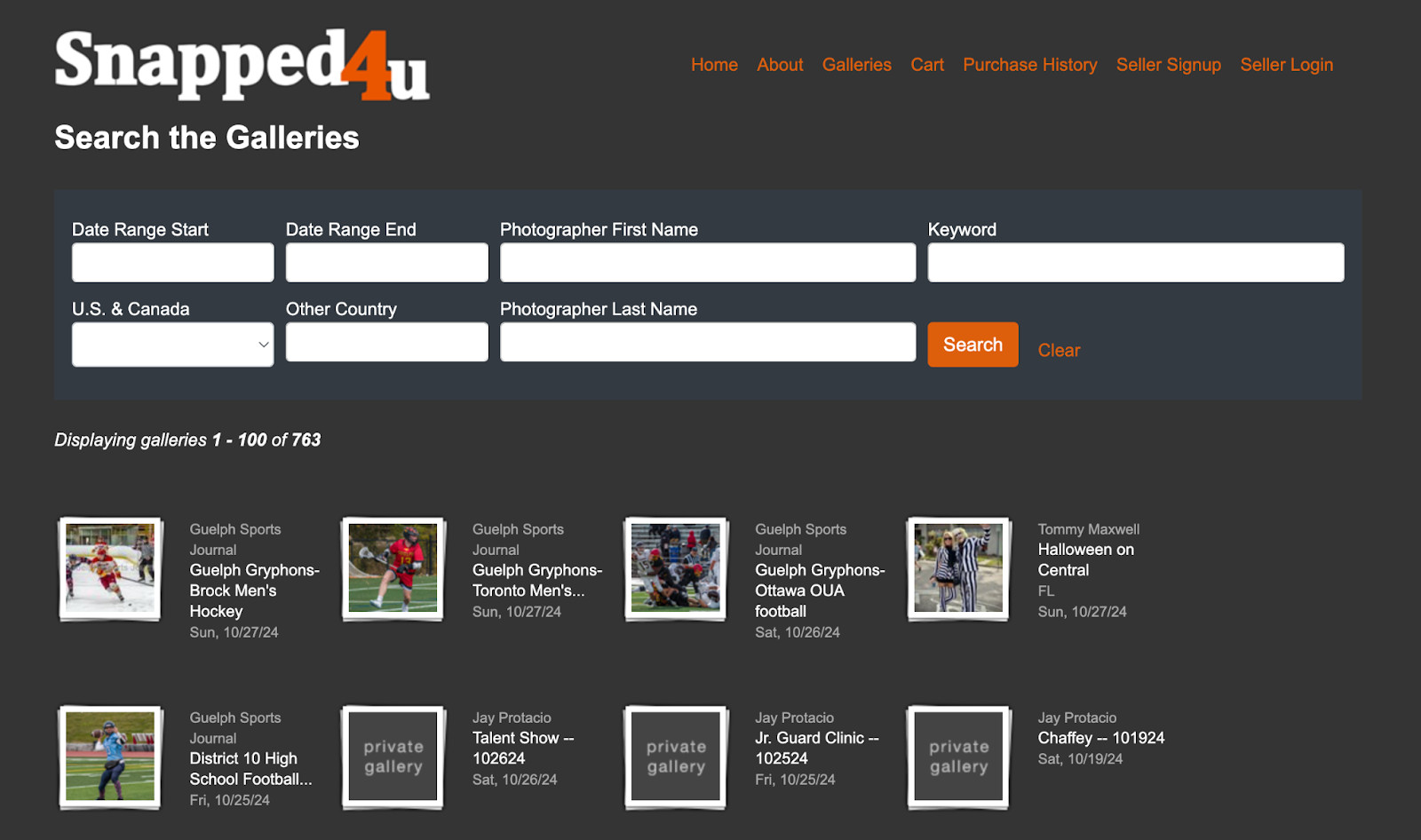 Snapped4U homepage showing photos from sports photographers
Snapped4U homepage showing photos from sports photographers
Dreamstime stands as a substantial microstock platform boasting an extensive library of over 250 million royalty-free media files. This vast collection includes stock photos, vector graphics, videos, and audio files, offering a wide range of content for buyers. With a user base exceeding 50 million, Dreamstime provides photographers with access to a large and active audience for their work.
Revenue Sharing and Affiliate Programs
Dreamstime offers a revenue-sharing model for contributors, providing 25% to 50% for non-exclusive content. Photographers who choose to contribute exclusively to Dreamstime can earn an additional 10% on their sales, along with a bonus of 20¢ for each approved submission. In addition to direct sales, Dreamstime features an affiliate program that allows contributors to earn 10% of transaction values generated by referred contributors or customers.
12. Snapped4U
 Foap creator landing page advertises a mobile app for photographers
Foap creator landing page advertises a mobile app for photographers
Snapped4U carves out a niche as a photo marketplace specifically tailored for event and portrait photographers. It provides a platform for photographers specializing in capturing moments and individuals to connect with clients seeking these types of images. Snapped4U enables photographers to create personalized galleries, giving them control over how their work is presented. Photographers also have the ability to set their own prices for their images, up to $20 per image, and sell digital files directly to their customers.
The platform is specifically geared towards photographers selling photos to clients who attended specific events or portrait sessions. It’s important to note that Snapped4U is not designed for general stock photos; travel, landscape, and still-life photos are typically not accepted on this platform.
Fees and Payment Schedule
Snapped4U involves a one-time registration fee of $10 during the sign-up process. In addition to this, the platform retains a commission ranging from 10% to 12% on each sale. Photographers receive their earnings, minus the commission, via PayPal on the 1st and 15th of each month, providing a regular payment cycle.
13. Foap
 Foap creator landing page advertises a mobile app for photographers
Foap creator landing page advertises a mobile app for photographers
Foap distinguishes itself by facilitating direct sales from photographers to brands and individuals, offering a marketplace where commercial-quality images can be readily purchased. Photographers on Foap can participate in “missions,” which are essentially contests or briefs set by brands outlining specific photo or video requirements. Winners of these missions are rewarded with cash prizes. To date, Foap has distributed over $3 million to its community of creators.
Missions and Market Sales
Mission payouts on Foap can range significantly, from $100 to $2,000, depending on the complexity and requirements of the brief. Beyond missions, users can also sell individual photos through the Foap market, providing a continuous sales avenue. Foap operates on a 50% commission basis for all sales, whether through missions or the marketplace.
14. EyeEm
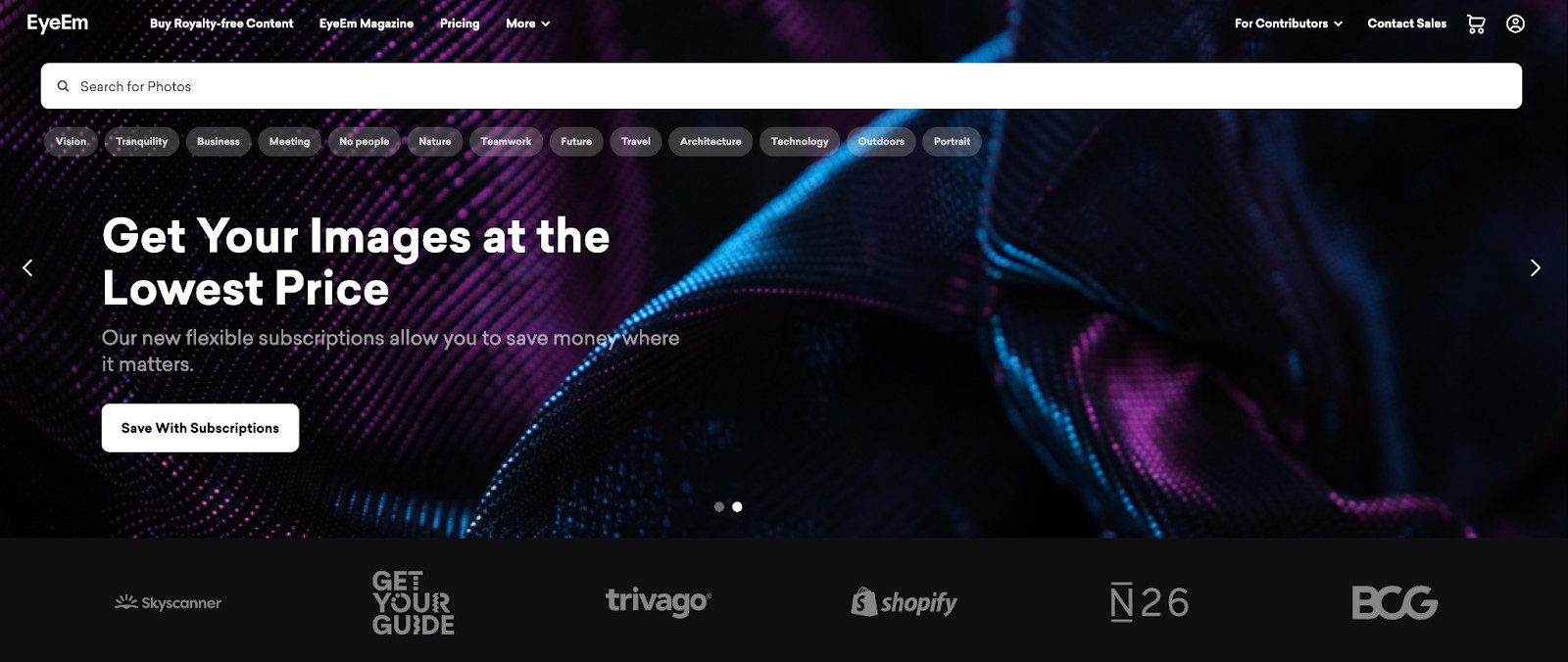 EyeEm homepage with a search bar and examples of high-profile clients
EyeEm homepage with a search bar and examples of high-profile clients
EyeEm combines the functionalities of a photo marketplace with a community platform for photographers, creating a space for both commerce and networking. The platform actively encourages photographers to participate in “missions” that center around specific themes or creative briefs, providing opportunities to create and submit images that meet particular demands.
Commission and Payment Method
Contributors to EyeEm earn a 50% commission on each sale made through the EyeEm marketplace. Payments to photographers are processed via PayPal, offering a convenient and widely used method for receiving earnings.
15. Pond5 (for videos)
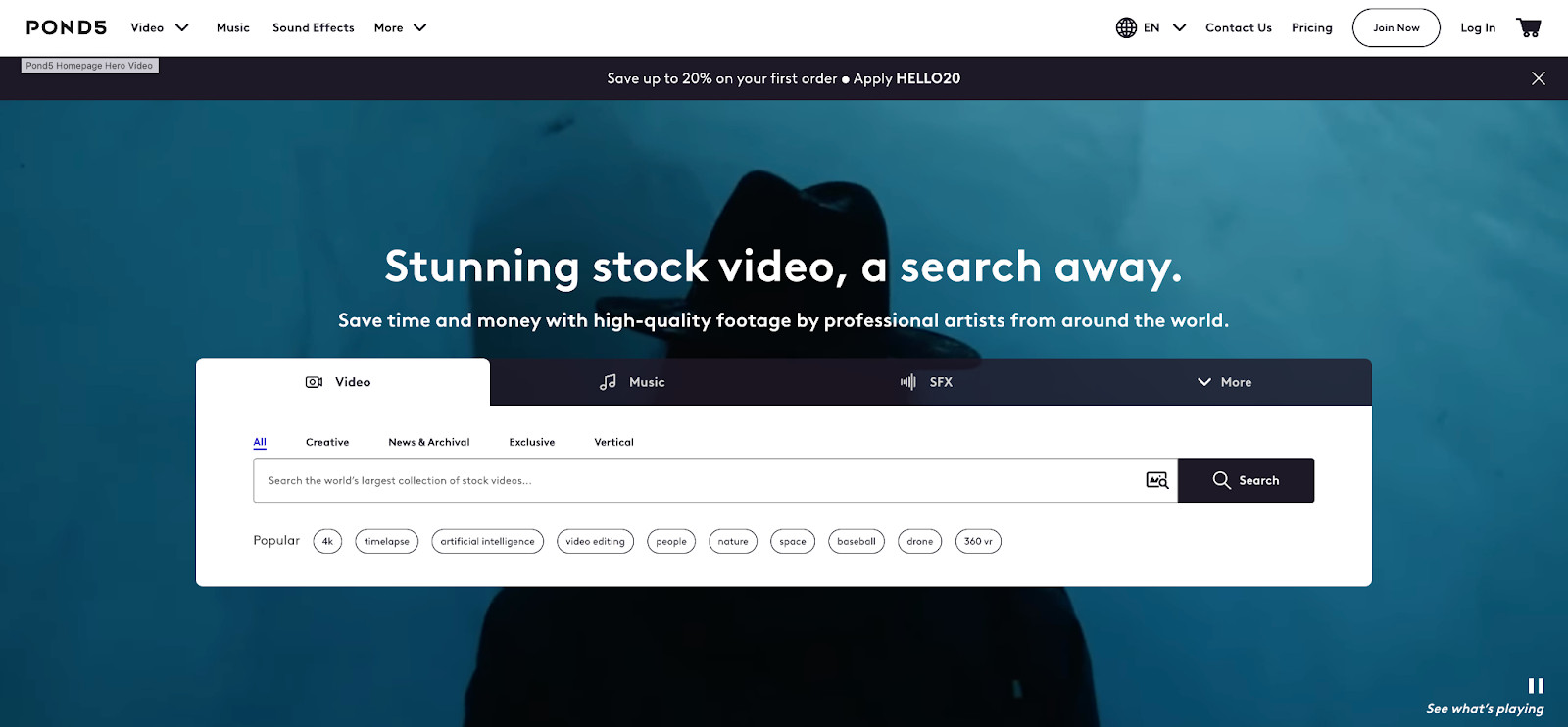 Pond5
Pond5
Pond5 differentiates itself by focusing on video content, catering to a market frequented by major brands and media clients. Unlike the predominantly photo-centric sites listed above, Pond5 specializes in royalty-free videos, music, sound effects, and other multimedia assets. According to Pond5, their customer base of one million includes prominent clients such as the BBC and Disney, with content from contributors being utilized in a range of projects including ads, TV shows, and feature films. Contributors on Pond5 can establish their own storefronts to showcase their media portfolios.
Royalties and Exclusivity Options
Video artists contributing to Pond5 earn a 40% royalty share on their sales. Pond5 also provides an option for contributors to make their content exclusive to the platform, which can increase the royalty rate up to 60%. Contributors can also respond to client briefs through the Artist Portal. Additionally, Pond5 offers a referral program, enabling artists to earn extra income by bringing new contributors or clients to the platform.
Essential Tips for Successfully Selling Photos Online
To build a thriving stock photo business, consider these key strategies:
Define Your Photography Niche
Establishing a consistent style or thematic focus is beneficial for photographers in the stock photo market. Whether your passion lies in travel, fashion, nature, or culinary photography, consistency can help you build a recognizable brand and attract a specific audience.
Many photographers organically discover their niche by exploring subjects and styles they enjoy shooting and that resonate with viewers. To gauge market demand for potential niches, keyword research tools can be invaluable. Analyzing search volume for terms related to your photographic interests can provide insights into popular and potentially profitable areas. Google Trends is a user-friendly tool that can help you identify image topics that are gaining traction and popularity.
Leverage Instagram
Similar to bloggers and YouTubers, photographers aiming to sell images online should prioritize building their audience and online presence.
Visually-driven social media platforms like Instagram are powerful tools for reaching a broad audience. Utilizing Instagram tools can assist in identifying relevant accounts to follow, engaging with trending hashtags, and cultivating a following of potential customers and clients.
Linking your social media accounts streamlines the process of sharing your photos across multiple platforms, enhancing your visibility and reach. On Instagram, for instance, you can link your account to automatically post images to Facebook simultaneously, saving time and maximizing your social media efforts.
Integrate Ecommerce into Your Website
Most photographers maintain a personal website to showcase their portfolio to prospective clients. By incorporating a Shopify Buy Button into your site, you can seamlessly enable customers to purchase stock images directly from you.
Photographer Dave Sandford, for example, effectively uses his website to not only display his stunning wildlife photography but also to sell prints and calendars directly to visitors.
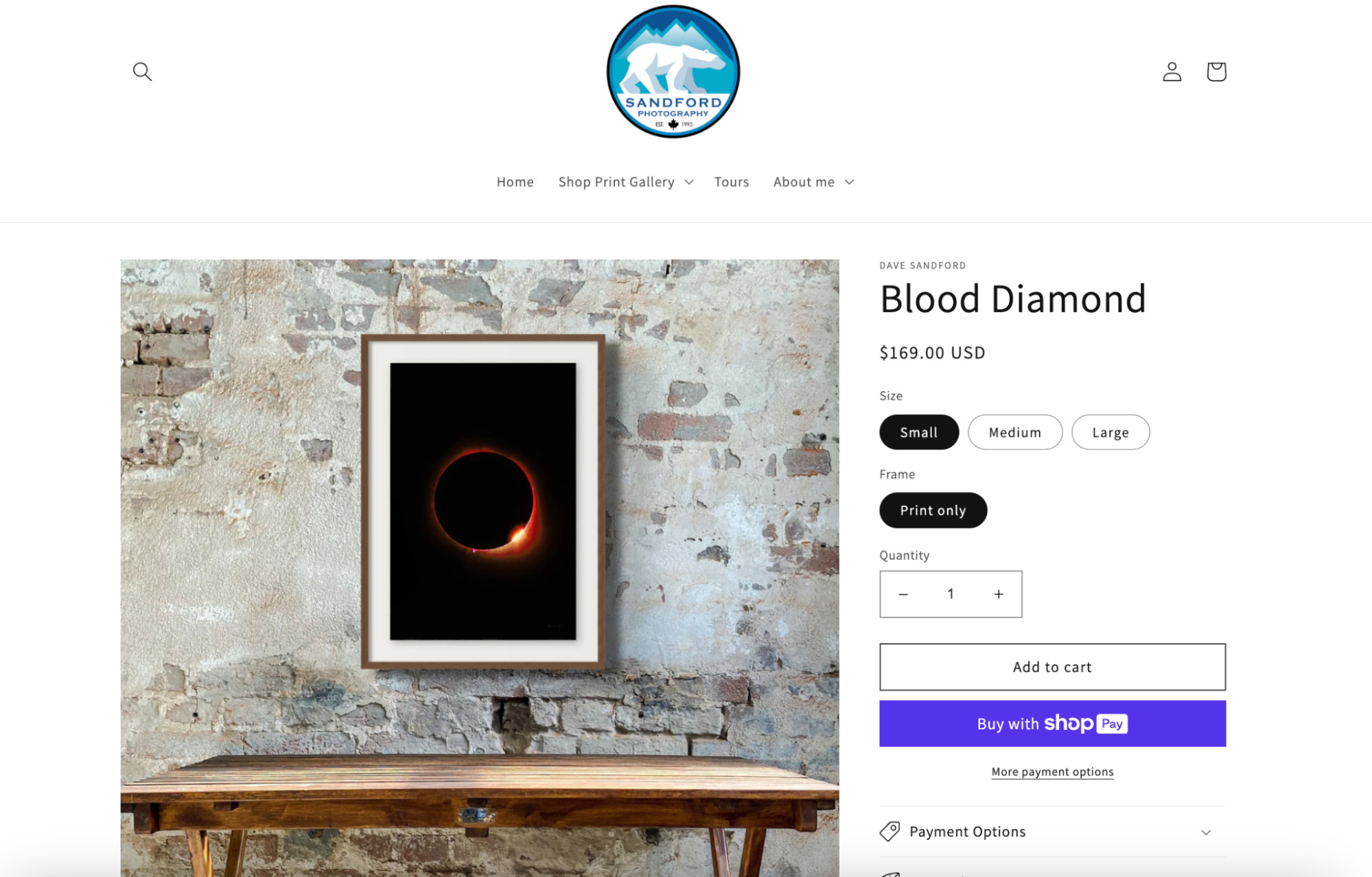 Product page for a print of a moon with a red border against a black background.
Product page for a print of a moon with a red border against a black background.
Creating a personalized portfolio page or online store on Shopify is one of the most straightforward ways to sell photos online.
Utilizing a pre-designed art and photography theme can simplify the process of setting up your digital showroom. Alternatively, you can combine a free theme with a gallery app to achieve a customized and visually appealing online store.
Understand Your Target Market
Identifying your target market—the specific group of people most likely to purchase your photos—is crucial for success. Understanding who they are, what their interests are, and what their purchasing needs are enables you to create photos that are directly appealing and commercially viable.
For example, if you specialize in wedding photography, it’s important to recognize that the primary buyers of wedding stock images are not typically engaged couples. Instead, your target market is more likely to be businesses within the wedding industry, such as wedding stationery brands or suit wholesalers who need royalty-free images of wedding celebrations for their marketing materials.
By understanding this buyer persona, you can tailor your photography to meet their specific needs, offer your images on platforms where they are actively searching for stock photos, and set prices that align with their budgets and expectations.
Steps to Set Up Your Online Photography Portfolio
Follow these steps to effectively launch your online photography portfolio and start selling:
1. Select the Right Platform
The “best” platform for monetizing your photos is subjective and depends on your business goals and desired level of control over your imagery.
Here’s a brief overview of platform options based on your objectives:
- For Hobbyists or Passive Income Seekers: Stock photo submission sites like iStock or Alamy are ideal for casual uploading and generating smaller amounts of passive income.
- For Assignment-Based Work: Unsplash+ is a good choice if you prefer to receive assignments from brands without direct pitching.
- For Full Control Over Your Business: Ecommerce platforms like Shopify offer complete control over your photography business, branding, and sales processes.
2. Plan Your Portfolio Structure
Your portfolio is your professional resume as a photographer, showcasing your best work to potential clients and buyers.
Pay close attention to these portfolio elements:
- Layout: While photos should be the focal point, adding context with mini product descriptions can enhance user engagement, influence purchase decisions, and improve your portfolio’s search engine optimization (SEO).
- Social Proof: Incorporate social proof to demonstrate the popularity and impact of your work. Include testimonials from satisfied customers or examples of how your images have been used in successful campaigns.
- Categories and Organization: Make it easy for visitors to browse your images by implementing clear categories and tags. For nature photography, consider organizing collections by location, environment, subject, and date.
- Gallery Size: Curate your online portfolio to only include your strongest, high-quality images that showcase your best work. Remove any photos you are not fully satisfied with to maintain a consistently professional impression.
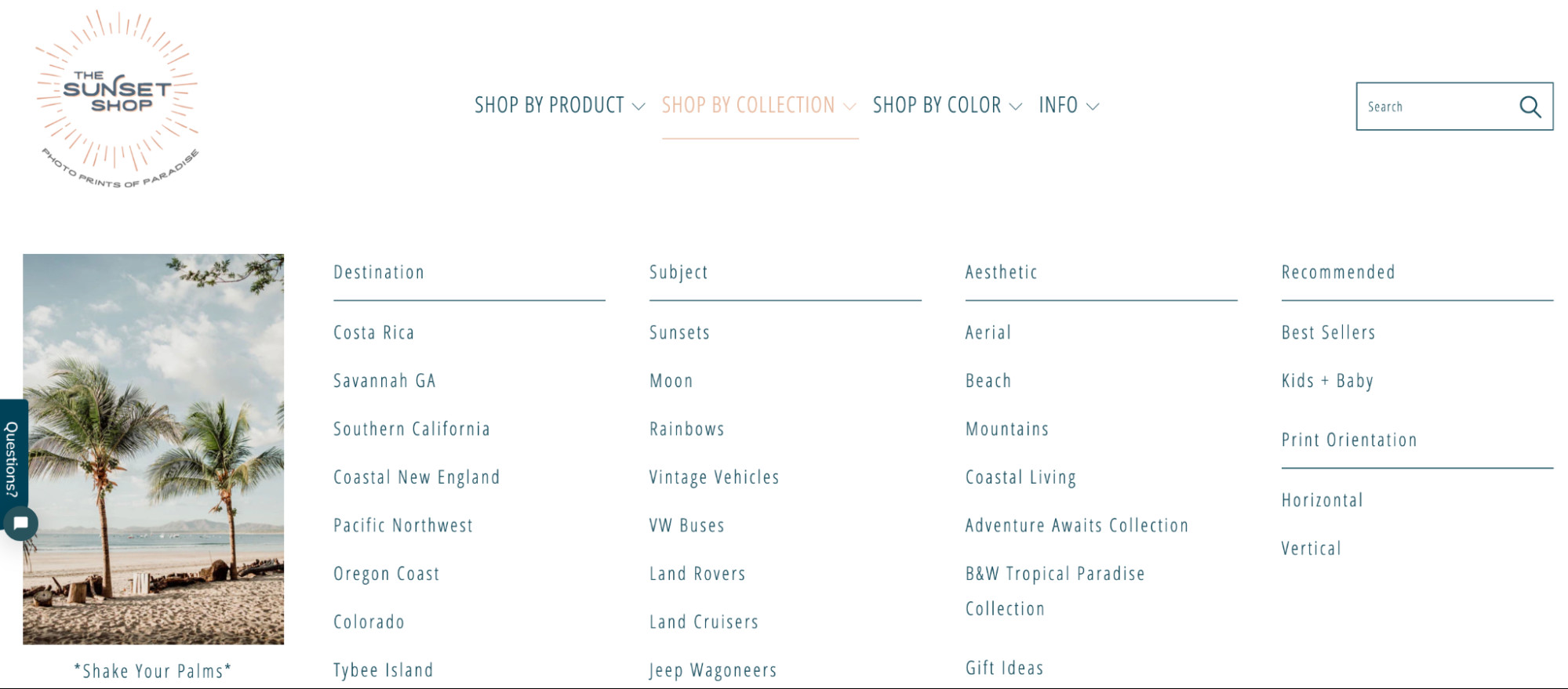 Example product categories on a photo print website include “Costa Rica”, “Sunset”, and “Mountains”.
Example product categories on a photo print website include “Costa Rica”, “Sunset”, and “Mountains”.
3. Optimize Images for the Web
While photographers strive for high-resolution images, optimizing images for web use is essential for user experience. Fast-loading images are crucial, as large image files can significantly slow down webpage loading times, leading to visitor frustration and abandonment.
When uploading images to your online portfolio:
- Compress Image Sizes: Reduce file sizes as much as possible without sacrificing visual quality. Aim for a compression rate between 60% and 80%.
- Use Descriptive File Names: Instead of generic names like “IMG_3542.jpg,” use descriptive filenames such as “summer-evening-nature.jpg” for better SEO and organization.
- Write Alt Text: Add alt text to each image. This descriptive text helps search engines understand the image content and improves accessibility for users with screen readers.
4. Create an Engaging About Page
People connect with people, so an informative and engaging About page is crucial for building trust and rapport with potential customers. Share your story, passion for photography, and what makes your work unique.
Use this space to develop your personal brand. Discuss how you entered the photography industry, the types of subjects you love to shoot, and your sources of inspiration.
5. Implement Ecommerce Functionality
An ecommerce platform streamlines the complexities of selling photos online, handling essential functions such as:
- Building an online storefront for self-service purchasing.
- Integrating with social media storefronts like Instagram Shop.
- Securely processing payments and managing sales taxes.
- Facilitating digital or physical product delivery.
- Managing marketing campaigns and promotions.
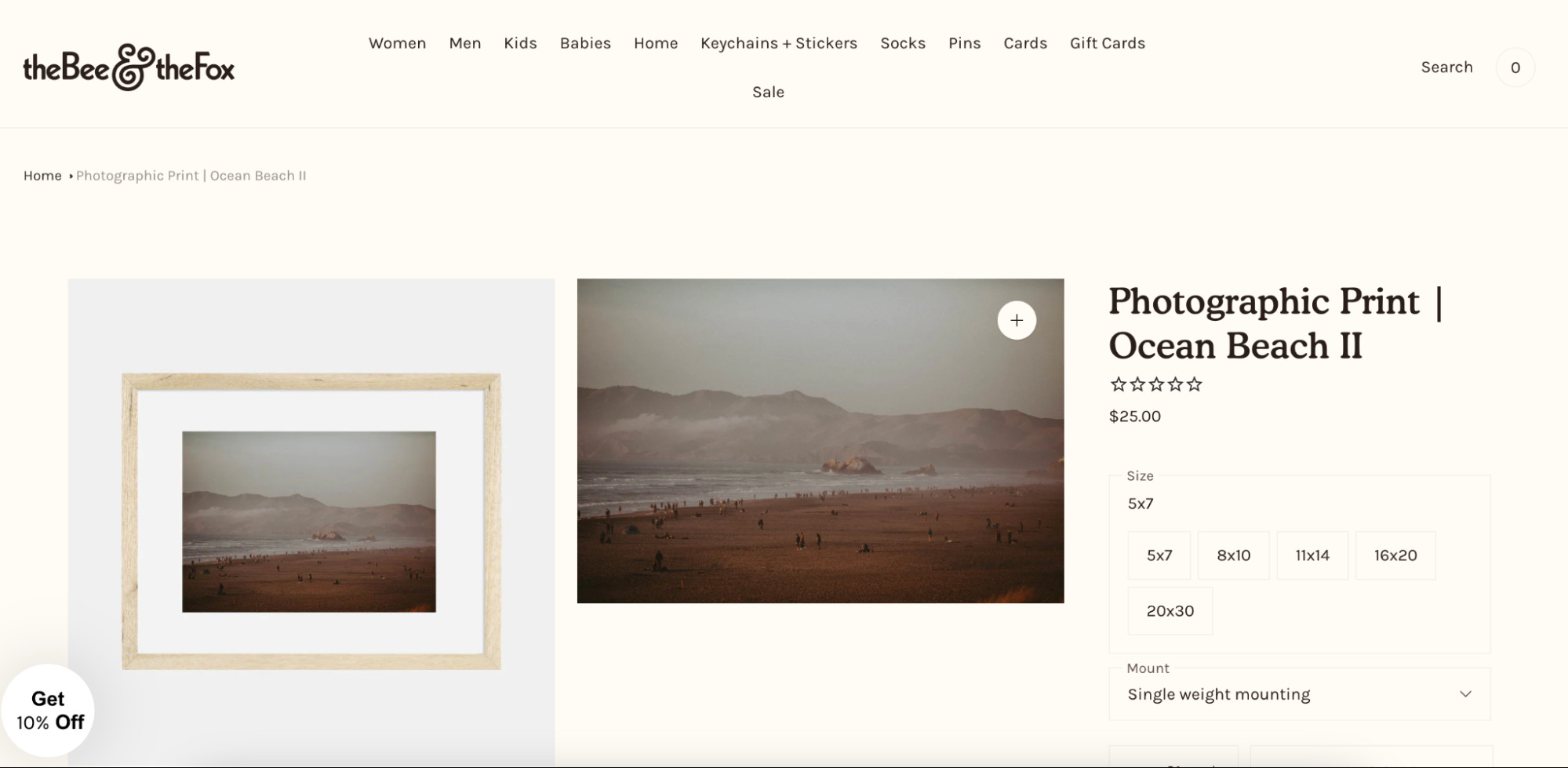 Product page for a 5×7 printed photo of a beach.
Product page for a 5×7 printed photo of a beach.
6. Ensure Mobile Compatibility
With mobile devices accounting for a significant portion of website traffic, ensuring your online portfolio is mobile-friendly is critical.
A mobile-optimized website involves:
- Responsive website design that adapts to different screen sizes.
- Vertical display of photos for easy mobile viewing.
- Use of large, finger-friendly buttons and navigation elements.
7. Launch and Promote Your Photos
Once your portfolio is set up, it’s time to promote it. Effective marketing tactics include:
- Reposting images on social media platforms.
- Pinning photos on Pinterest with links back to your portfolio.
- Offering free prints to influencers for exposure.
- Sharing behind-the-scenes content on platforms like TikTok, YouTube, and Instagram Reels.
- Building an email list by offering discounts to website visitors.
Expanding Your Sales: Prints and Photo Books
You can diversify your income by selling physical products featuring your photography, such as framed prints, mugs, t-shirts, and calendars.
Selling physical products can be simpler than you might think. You can partner with a local photo lab for printing and shipping or utilize a print-on-demand company for dropshipping a wider range of products.
Before selling, always order samples to ensure product quality aligns with your photographic standards.
Creating Photo Books
Photo books are another excellent physical product option. Niche and thematically consistent photography is well-suited for creating compelling photo books.
While print-on-demand services may offer lower profit margins, they provide a risk-free way to test market demand before making larger upfront investments.
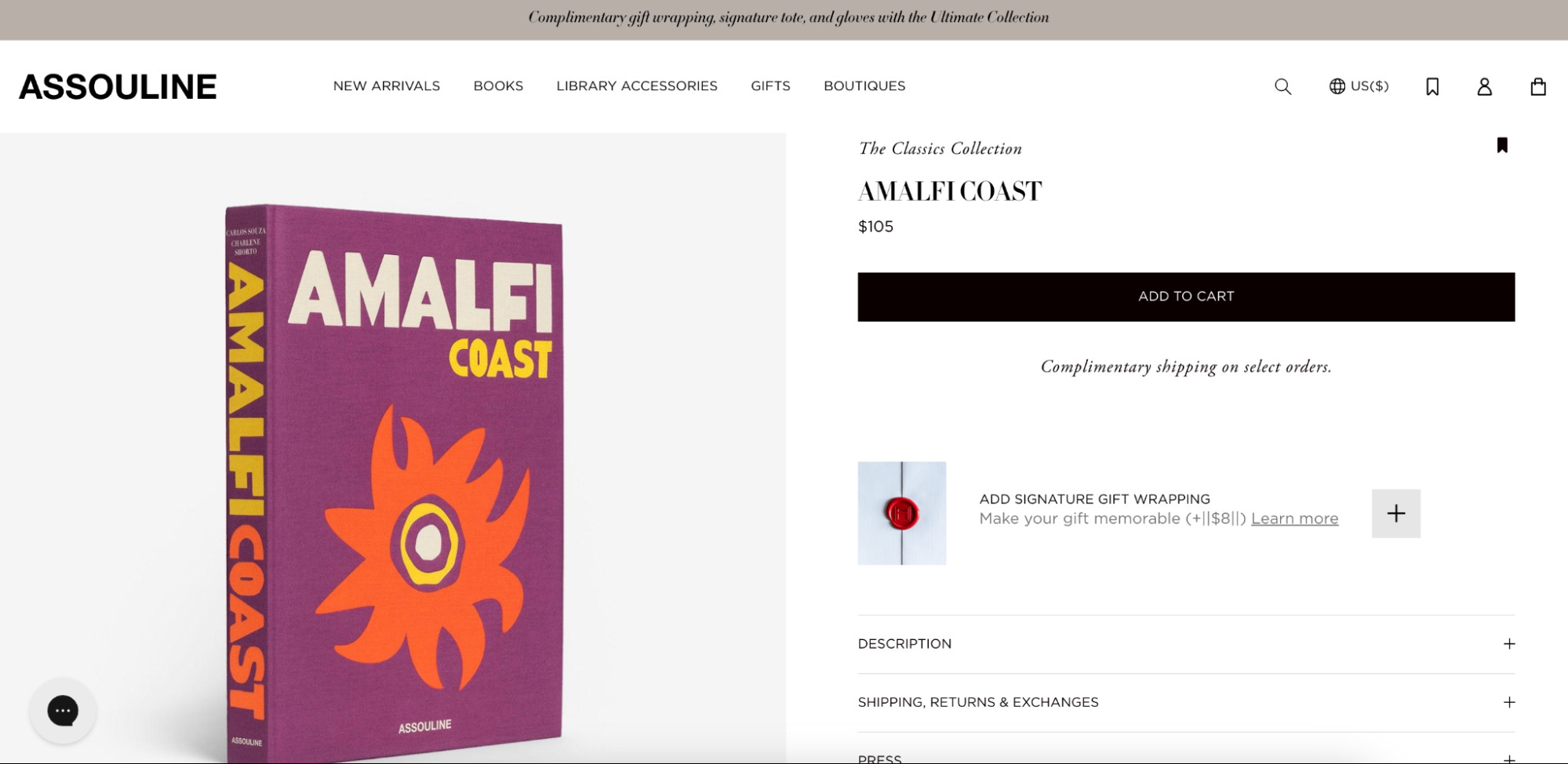 Photobook of images taken on the Amalfi Coast.
Photobook of images taken on the Amalfi Coast.
Selling Your Photography Services
Beyond stock photos and products, you can also sell your photography services for events, fashion shoots, product photography, and more.
List your services on freelance directories like Fiverr and Upwork, and consider local networking and video chat consultations.
Networking tips for service-based photography:
- Always carry business cards.
- Optimize your LinkedIn profile to showcase your services.
- Attend networking events frequented by entrepreneurs and event organizers.
- Build a strong personal brand by consistently sharing your work on social media.
Utilize booking platforms like Setmore or SimplyBook.me, or scheduling apps for Shopify, to manage client bookings and appointments efficiently.
Pricing Strategies for Online Photo Sales
Your earning potential depends on your talent and dedication, but strategic pricing is key.
Pricing strategy tips:
- Market Research: Research competitor pricing and ask your target market about their willingness to pay.
- Profit Margins: Factor in photography costs, website fees, and marketing budgets when setting prices.
- Usage-Based Pricing: Charge more for exclusive licenses than non-exclusive ones.
- Discounts and Promotions: Offer discounts to attract new customers and reward loyal fans.
- Product Bundles: Sell collections of related images at a discounted bundle price.
Legal Basics for Selling Photos Online
Understanding legal terms and concepts is crucial for protecting your rights when selling photos online.
Key legal terms:
- Editorial Use: For use in news, blogs, and publications.
- Commercial Use: For marketing and advertising.
- Retail Use: For creating physical products for sale.
- Exclusive Use: License granted to a single buyer.
- Non-Exclusive Use: Licenses sold to multiple buyers.
- Public Domain: Photos without copyright restrictions.
- Creative Commons: Conditional usage with attribution requirements.
- Royalty Free: Unlimited usage with a one-time license fee.
- Rights Managed: One-time license with usage restrictions.
- Right of Publicity: Rights of individuals in photos, requiring permission for commercial use.
Addressing Photo Theft
Photo theft is a common concern. Watermarking your images before sharing them online is a proactive protective measure.
If theft occurs, a cease and desist request or an invoice for unauthorized use can be effective. Combining both is often the most persuasive approach.
Always aim to receive credit for your work, even for editorial use, as backlinks to your portfolio improve SEO and drive traffic.
How to Sell Photos Online FAQ
What is the best way to sell photographs?
Selling photographs as stock images on third-party websites like iStock, Shutterstock, or Alamy is often considered the best way due to ease of use and broad market access.
Where can I sell my photos online for money?
Platforms include: Alamy, 500px, Shutterstock, Getty Images, iStock, Stocksy, Picfair, Adobe Stock, Envato Elements, Unsplash+.
How do you make money from stock photography?
Stock photography websites license your uploaded images to clients. You earn royalties from each image license sale.

